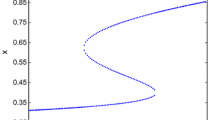Abstract
This work gives a mathematical foundation for bifurcation from a stable equilibrium in the genome. We construct idealized dynamics associated with the genome. For this dynamics, we investigate the two main bifurcations from a stable equilibrium. Finally, we give mathematical proofs of existence and points of bifurcation for the repressilator and the toggle gene circuits.







Similar content being viewed by others
References
J. Monod, F. Jacob. General conclusions: Teleonomic mechanisms in cellular metabolism, growth, and differentiation. Cold Spring Harb. Symp. Quant. Biol. 26 (1961), 389-401.
S. Kauffman, W. S. McCulloch. Random Nets of Formal Genes. Quarterly Progress Report 34. Research Laboratory of Electronics, Massachusetts Institute of Technology, 1967.
S. Kauffman. Metabolic stability and epigenesis in randomly constructed genetic nets. Journal of Theoretical Biology, 22 (1969), 437-467.
L. Glass. Classification of biological networks by their qualitative dynamics. Journal of Theoretical Biology, 54 (1975), 85-107.
L. Glass, J. S. Pasternack. Stable oscillations in mathematical models of biological control systems. Journal of Mathematical Biology, 6 (1978), 207-223.
S. P. Hastings, J. Tyson, D. Webster. Existence of Periodic Solutions for Negative Feedback Cellular Control Systems. Journal of Differential Equations, 25 (1977), 39-64.
J. Mallet-Paret, H. L. Smith. The Poincare-Bendixson theorem for monotone cyclic feedback systems. Journal of Dynamics and Differential Equations, 2 (1990), 367-421.
T. Gedeon, K. Mischaikow. Structure of the global attractor of cyclic feedback systems. Journal of Dynamics and Differential Equations, 7 (1995), 141-190.
P. Bürgisser, F. Cucker. Condition: The Geometry ofNumerical Algorithms. Springer Verlag 2013.
U. Alon. An Introduction to Systems Biology: Design Principles of Biological Circuits. Boca Raton, FL: Chapman & Hall/CRC Press, 2006.
F. R. Chung. Spectral graph theory, Vol 92, American MathematicalSoc., 1997.
R. Edwards, L. Glass. Dynamics in Genetic Networks. The American Mathematical Monthly. 121 (2014),793-809.
I. Rajapakse, M. Groudine. On Emerging Nuclear order. Journal of Cell Biology, 192 (2011), 711-721.
M. W. Hirsch, S. Smale. Differential Equations, Dynamical Systems, and Linear Algebra, Academic Press, 1974.
S. Wiggins. Introduction to applied nonlinear dynamical systems and chaos. Springer-Verlag, New York, second edition, 2003
J. Guckenheimer, P. Holmes. Nonlinear Oscillations, Dynamical Systems, and Bifurcations of Vector Fields, Springer, New York, 2002.
Y. A. Kuznetsov. Elements of applied bifurcation theory. Springer-Verlag, New York, second edition, 1998.
A. I. Mees, L. O. Chua. The Hopf bifurcation theorem and its applications to nonlinear oscillations in circuits and systems. IEEE Trans. Circ. Syst., 26 (1979), 235–5.
J. E. Marsden, M. McCracken. The Hopf Bifurcation and Its Applications. Applied Mathematical Sciences. Vol.19. Springer-Verlag , New York, NY, 1976.
E. Hopf. Abzweigung einer periodischen Losung von einer stationaren Losung eines Di erentialsystems. Ber Math Phys Kl Sachs Akad Wiss Leipzig, 94 (1942), 1-22.
J. C. Alexander, J. A. Yorke. Global bifurcations of periodic orbits. American Journal of Mathematics, 100 (1978), 263-292.
J. Mallet-Paret, J. A. Yorke. Snakes: Oriented families of periodic orbits, their sources, sinks, and continuation. Journal of Differential Equations, 43 (1982), 419- 450.
T. S. Gardner, C. R. Cantor, J. J. Collins. Construction of a genetic toggle switch in Escherichia coli. Nature, 403 (2000), 339-342.
S. P. Ellner, J. Guckenheimer. Dynamics models in biology. Princeton University Press, Princeton, New Jersey, 2006.
M. B. Elowitz, S. Leibler. A synthetic oscillatory network of transcriptional regulators. Nature, 403 (2000), 335-338.
O. Buse, A. Kuznetsov, R. Pérez. Existence of limit cycles in the repressilator equation. Int. J. Bifurcation Chaos, 19 (2009), 4097-4106.
V. Guillemin, A. Pollack. Differential Topology. Prentice-Hall, 1974.
Acknowledgments
We would like to thank Yan Jun, Lu Zhang, Lindsey Muir, Geoff Patterson, Xin Guo, Anthony Bloch, an anonymous referee and especially Mike Shub for helpful discussions. We extend thanks to James Gimlett and Srikanta Kumar at Defense Advanced Research Projects Agency for support and encouragement.
Author information
Authors and Affiliations
Corresponding author
Additional information
Communicated by Michael Shub.
Appendices
Appendix 1
The existence of a pitchfork bifurcation in the two-gene case
When \(\alpha _{1}=\alpha _{2}=2,\) and \(m=n>0,\) the system in Eq. (11) can be written as
Proposition 2
For our system given by A1, for \(0\le m\le 2,\) every equilibria must be \(\left( 1,1\right) .\) This can be proved by numerics.
The Jacobian matrix J at (1, 1)
and the \(det(J)=1-\frac{1}{4}m^{2}.\) Therefore, \(0\le m<2,\) \(\ det(J)>0,\) and \(m=2\), \(\ det(J)=0;\) this is a condition for a pitchfork bifurcation.
Appendix 2
The existence of a Hopf bifurcation in the three-gene case
A simple case of the repressilator can be written as
The diagonal \(x=y=z=s,\) is parameterized by s. Then, the coordinates of an equilibrium state are (s, s, s), and the equilibrium path is described by
The Jacobian matrix J at (s, s, s) is
The real part of the complex eigenvalues is, Re\((\lambda )=\) \(-\frac{1}{2}\left( \frac{-ms^{m}}{\left( s^{m}+1\right) }\right) -1.\) The condition for a Hopf bifurcation is thus
This further simplifies to \(s^{m}(2-m)=-2\) and for any \(m>2,\) the following equation determines a bifurcation value for s.
Therefore, this satisfies the conditions for a generic Hopf bifurcation. See [25] for a related treatment.
Appendix 3
The existence of a pitchfork bifurcation in the three-gene case
As an example in Case 2 (Sect. 5), for the system described in Eq. (12), we take
The equilibria of the system C1 are
Proposition 3
For our system given by C1, \(0\le m\le 2,\) all equilibria \(\left( x,y,z\right) \) must be \(\left( 1,1,1\right) .\) This can be proved by numerics ( Stephen Lindsly).
The Jacobian matrix is
The \(det(J)=\) \(\frac{1}{8}m^{3}-1,\) which is zero exactly when \(m=2\). This satisfies the conditions for the existence of a Pitchfork bifurcation.
Rights and permissions
About this article
Cite this article
Rajapakse, I., Smale, S. Mathematics of the Genome. Found Comput Math 17, 1195–1217 (2017). https://doi.org/10.1007/s10208-016-9316-x
Received:
Revised:
Accepted:
Published:
Issue Date:
DOI: https://doi.org/10.1007/s10208-016-9316-x




